Caterpillars found in New York demonstrate remarkable resilience, enduring extreme winters, scorching summers, and the daily risk of being stepped on by humans. Yet, they persevere, continuously devouring and growing, never abandoning their aspiration to transform into magnificent butterflies or moths. New York is home to a diverse array of caterpillar species, ranging from the common monarch butterfly caterpillar to the rare Karner blue butterfly caterpillar. These caterpillars inhabit various habitats, including forests, fields, and gardens. They play a vital ecological role by pollinating plants and serving as a food source for other animals.
The Classification of Caterpillars
In addition to their scientific classifications, caterpillars also go by various common names, which can differ depending on the species they belong to. For instance, the caterpillar of the monarch butterfly is known as the monarch caterpillar, while the caterpillar of the cabbage moth is called a cabbage looper. Scientists rely on several key features to classify caterpillars, including the number of pairs of prolegs (which are fleshy appendages used for gripping surfaces), the number of stemmata (simple eyes) on their heads, the presence or absence of crochets (hooks) on their prolegs, the shape of their head capsules, and the type of scales covering their bodies. By studying these features, scientists can not only identify different caterpillar species but also gain valuable insights into their biology and ecology. Another prominent question that often arises though, is how we can discern whether it will develop into a moth or a butterfly.
A Moth or Butterfly?
Butterflies and moths are captivating creatures belonging to the insect order Lepidoptera, a name derived from the Greek term “scale-winged”. These remarkable organisms share common qualities, including four delicate wings adorned with tiny scales. However, it’s important to note that distinct characteristics distinguish these two taxonomic groups. For example, butterflies tend to have thinner antennae while moths have antennae that are feathery or saw-toothed.
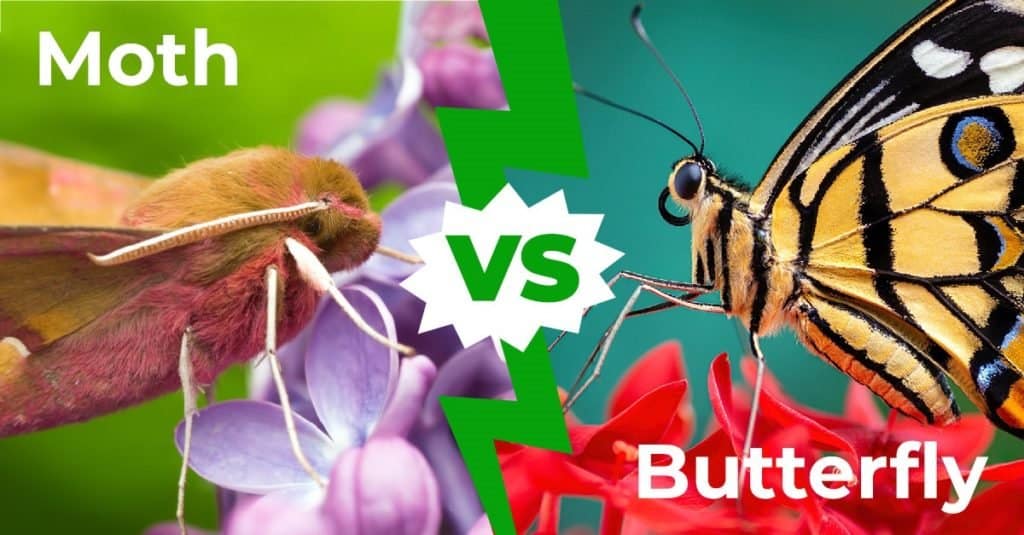
Common Caterpillars Found in New York
Caterpillars are extraordinary creatures, displaying a multitude of abilities that enable them to thrive. Many of these insects have also evolved various defense mechanisms that aid in their survival. Some caterpillars can sting with their long spines, while others are poisonous to predators who try to eat them. Others, however, have their unique defenses that aren’t quite so dangerous. Here are some of the common (and non-poisonous) caterpillars in New York!
1. Eastern Tent Caterpillar (Malacosoma americanum)
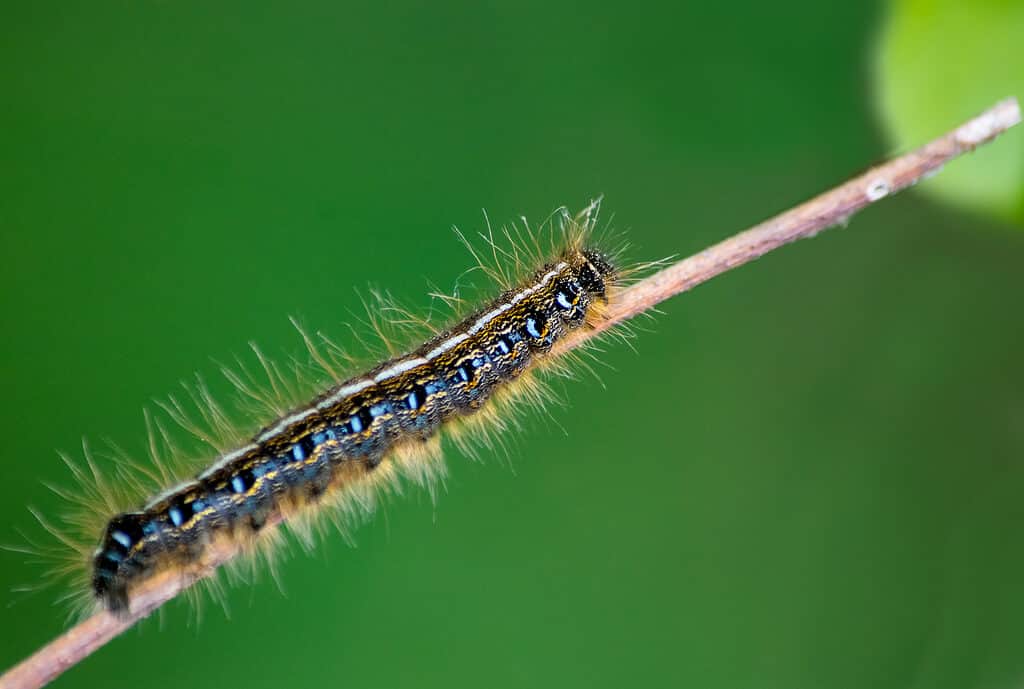
Eastern tent caterpillars are not poisonous, but their hairs can irritate human skin and cause itching.
©K Quinn Ferris/Shutterstock.com
The eastern tent caterpillar lives all over the state of New York and follows a fascinating life cycle. As summer approaches, adults diligently lay clusters of 150 to 350 eggs on the twigs of their host trees, ensuring their survival through winter and hatching in the spring. Young caterpillars start small and black but quickly feast on the leaves, molting as they grow. As they reach their final phase, they sport a 2-inch long body marked by a striking white stripe along their backs. Their sides further come alive with fragmented lines of yellow and brown, adorned with distinctive oval spots of mesmerizing blue. When fully matured, they masterfully construct silken tents in branch crotches, where they undergo a transformative two-week pupation period. Towards the end of July or the start of August, adult butterflies emerge from their pupae.
2. Woolly Bear Caterpillar (Pyrrharctia isabella)
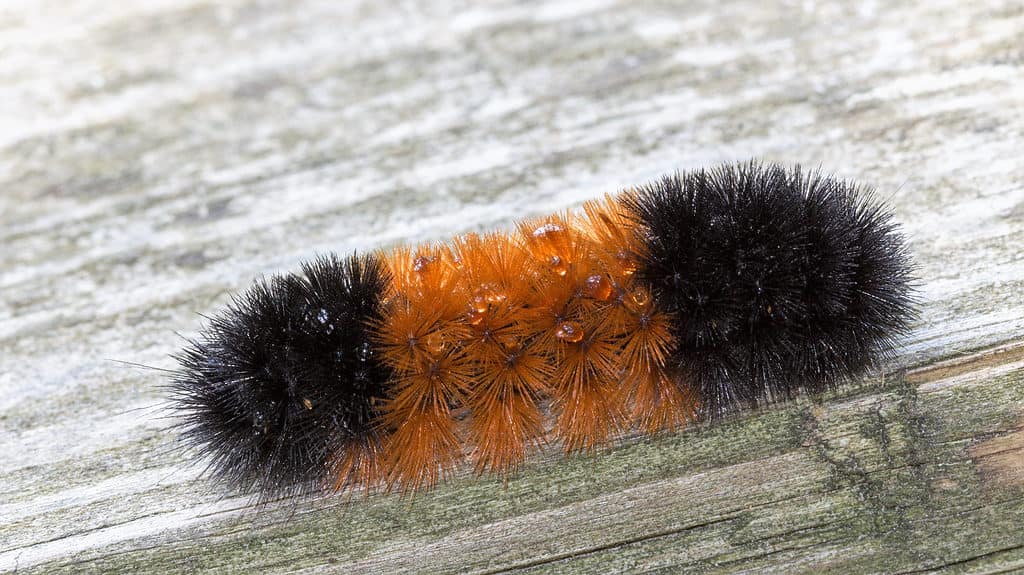
Woolly bear caterpillars are found all over New York in many different habitats.
©Kimberly Boyles/Shutterstock.com
The woolly bear caterpillar is a fascinating creature native to New York. These delightful caterpillars can be observed in diverse habitats, from forests and meadows to gardens, where they feast on a varied diet of dandelions, clover, and asters. During the fall season, they showcase their vibrant and fuzzy presence while preparing themselves for the upcoming winter. These remarkable creatures seek solace in protected enclaves like logs or rocks, adopting a compact ball shape to withstand the harshest winter conditions. As spring arrives, they emerge from their winter slumber, rejuvenated and ready for a new chapter. They undergo a nourishing journey, transforming into graceful adult forms.
3. Fall Webworm Caterpillar (Hyphantria cunea)
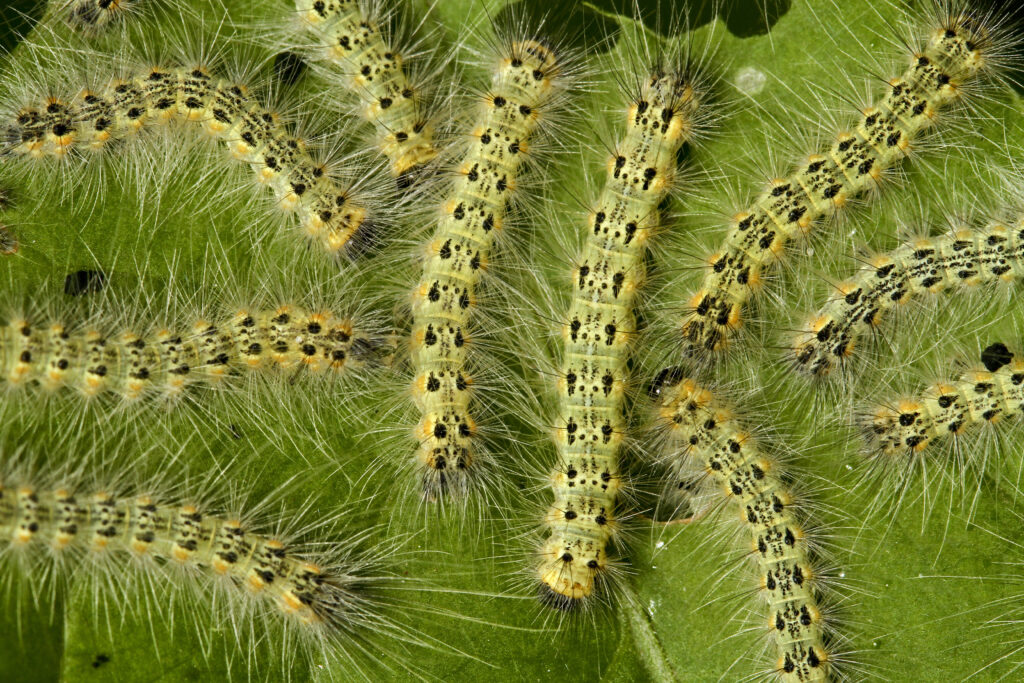
Fall webworm moth caterpillars spin their unique webs in the late summer and fall.
©Geza Farkas/Shutterstock.com
The fall webworm caterpillar is a native insect in North America. Its habitat spans from southern Canada to northern Mexico, encompassing diverse areas such as forests, parks, and gardens. These caterpillars have a broad diet, feasting on various hardwood trees like oak, maple, birch, and cherry. During late summer and fall, fall webworms make their presence known by weaving sizable silken webs on tree branches. However, they pose no significant danger to the trees. Although the webs may not be aesthetically pleasing and can cause defoliation, the resulting damage from these caterpillars is generally minimal, and the affected trees typically recover naturally.
4. Cabbage Worm Caterpillars (Pieris rapae)
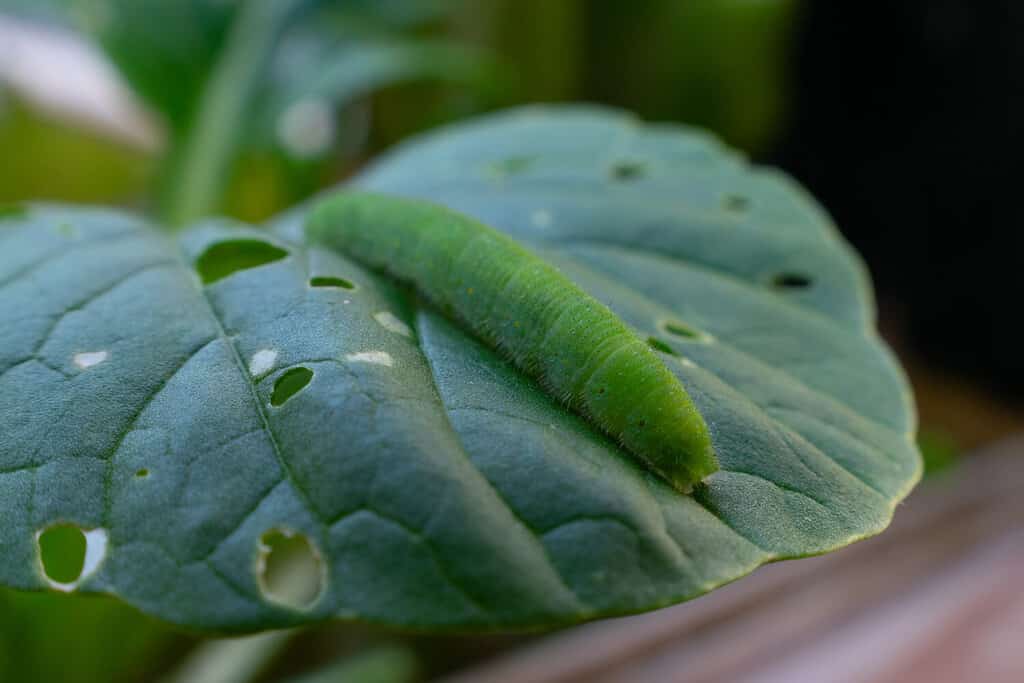
Cabbage worms are not native to North America. They were introduced through imports and shipments of plants.
©Kelsey Armstrong Creative/Shutterstock.com
The caterpillars of the elegant cabbage white butterfly, commonly called cabbage worms, have vibrant green bodies. They can be found in various habitats, including gardens, farms, and even our backyards. Cabbage worms live all over New York State. However, cabbage worms can be notorious troublemakers and pose a significant threat to cabbage and other cruciferous vegetables like broccoli, cauliflower, and kale.
5. Karner Blue Butterfly Caterpillar (Plebejus samuelis)
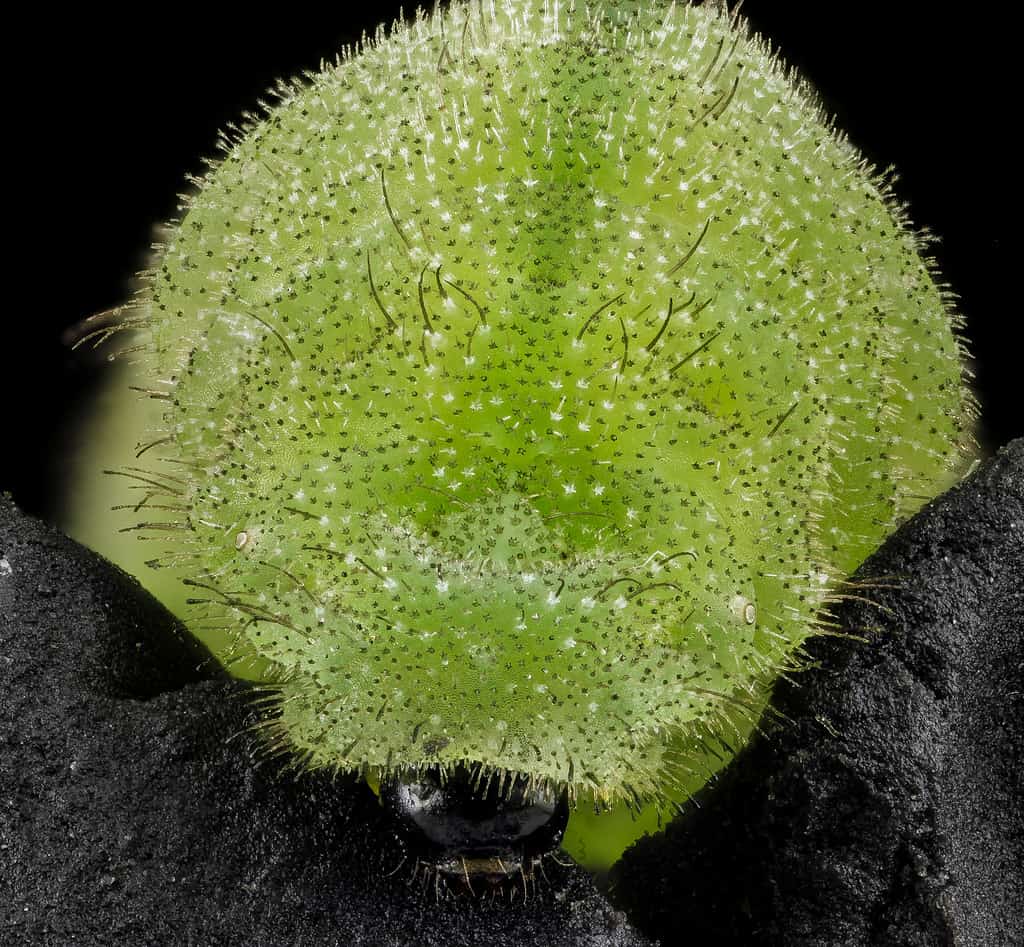
Karner blue butterfly caterpillars forage for food from late May to early July and transform into butterflies in late July or early August.
©Sam Droege / Public Domain – License
The captivating Karner blue butterfly, an endangered species, graces the enchanting landscapes of New York State. The caterpillars of this magnificent creature measure a mere inch in length, boasting a lustrous black body adorned with intricate blue stripes. While other creatures may indulge in a varied diet, these caterpillars possess a unique preference, solely feasting upon the tender leaves of wild blue lupine plants. Karner blue butterfly caterpillars live in open woods, sunlit clearings, and dry, sandy terrains. In New York, you’ll only find them in the Hudson Valley sand belt. They transform into stunning Karner blue butterflies, with dark blue or silver and black wings, or blue and grayish brown with orange and black patterns.
6. Crecropia Moth Caterpillar (Hyalophora cecropia)
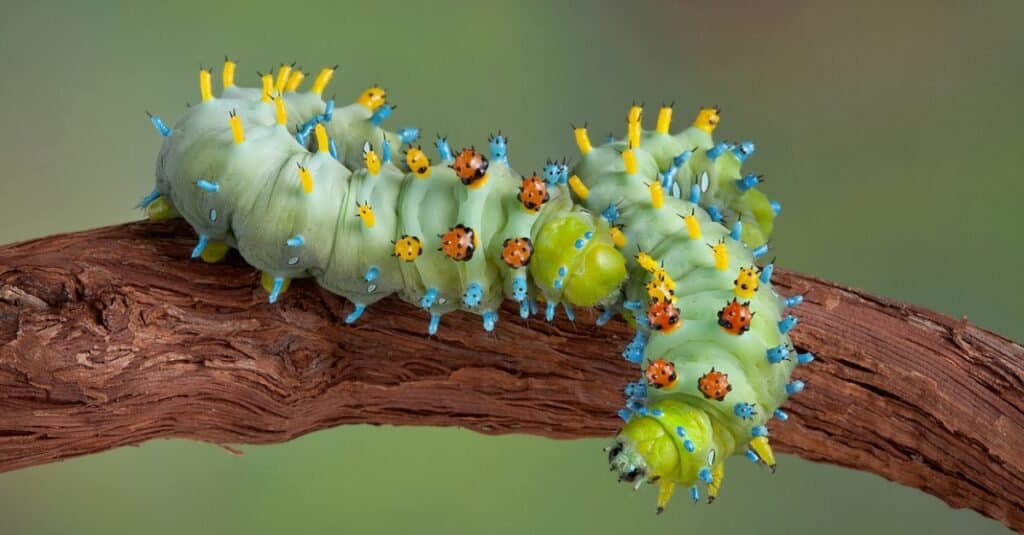
©Cathy Keifer/Shutterstock.com
In New York, a creature both rare and striking can be found: the illustrious Cecropia moth caterpillar. While its presence may no longer be as prevalent as in ages past, remnants of this enigmatic species can still be discovered, predominantly dwelling within the captivating eastern regions where towering arboreal wonders beckon. Nourishing its voracious appetite, this majestic creature indulges in the succulent foliage of various trees, including the oak, maple, and willow. When the time is right, the caterpillar seeks refuge upon a branch or leaf and diligently weaves a magnificent silk chrysalis. After just two weeks, a breathtaking creature emerges, the resplendent Cecropia moth. With delicate reddish-brown wings adorned in a tapestry of tan, red, and white markings, this winged marvel boasts an impressive wingspan stretching 5 to 7 inches across.
7. Hickory Horned Devil Caterpillar (Citheronia regalis)
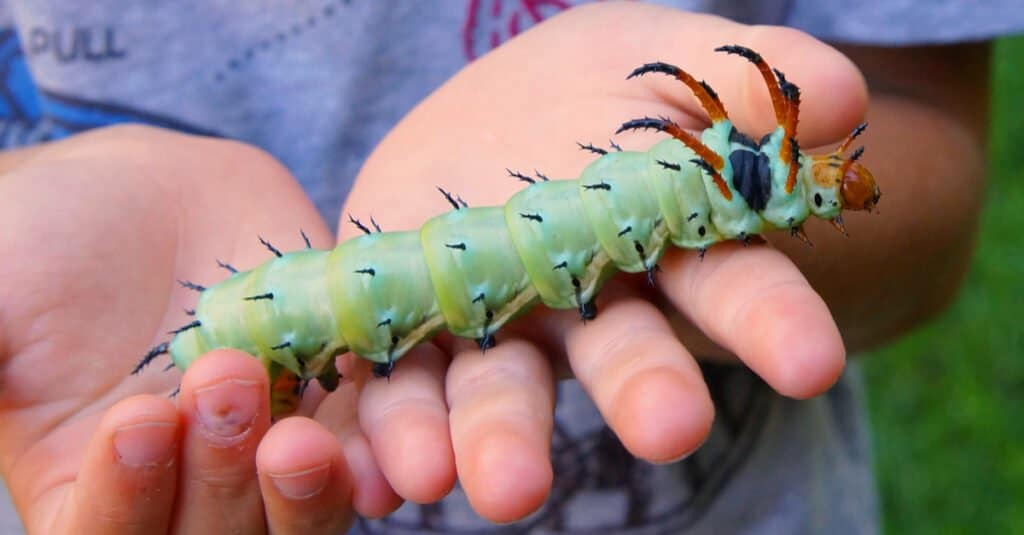
The hickory-horned devil caterpillar uses its horn to protect itself from predators.
©Matt Jeppson/Shutterstock.com
Another captivating insect in New York is the hickory horned devil caterpillar. This magnificent and imposing creature earns its name from its impressive appearance. Stretching approximately 5 inches in length, it boasts a vibrant emerald or jade green body, gracefully punctuated by black-tipped red horns that crown its second and third thoracic segments. Short yet formidable spiny projections also adorn the rest of its body. The hickory horned devil caterpillar has a fearsome exterior, but this enchanting creature poses no threat to humans. The caterpillar eats the leaves of deciduous trees including walnut and hickory, and transforms into the massive royal walnut moth.
Poisonous Caterpillars in New York
New York is home to numerous toxic caterpillar species. If you encounter a poisonous caterpillar, quickly cleanse the affected area with soap and water and seek medical attention, if necessary. New York has various poisonous caterpillars, and caution should be exercised to prevent rashes, itching, swelling, or painful stings from their toxins or spiky hairs.
| Ways of Being Poisonous | Example / Description |
|---|---|
| Poisonous body/blood | Certain caterpillars consume poisonous plants and store the toxins within their bodies. If these caterpillars are ingested, their toxins have the potential to induce illness in their predators. |
| Poisonous/venomous spines or hairs | These spines or hairs are frequently linked to glands containing poison or venom. Upon contact, the spines or hairs detach and deliver the toxin directly into the victim. |
| Poisonous liquid | Certain caterpillars have the remarkable ability to generate a toxic substance, which they release either from their mouths or their rear ends. This potent liquid is capable of causing skin irritation, intense burning sensations, and, in extreme cases, even blindness. |
8. Monarch Butterfly Caterpillar (Danaus plexippus)

Monarch butterfly caterpillars feed on milkweed, which makes them poisonous to any predators who may want to eat them.
©iStock.com/CathyKeifer
The female monarch butterfly exhibits a carefully orchestrated life cycle, laying her eggs with precision on the underside of milkweed leaves. Within a mere four days, minuscule caterpillars emerge, fueled by an insatiable appetite for milkweed leaves as they undergo rapid growth, molt after molt. After approximately 10 days, the caterpillars delicately fasten themselves upside down to a milkweed leaf, encasing their bodies in a pupa, or chrysalis. Inside this protective sanctuary, a remarkable transformation occurs, culminating in the emergence of resplendent adult butterflies.
9. Brown-Tail Moth Caterpillar (Euproctis chrysorrhoea)
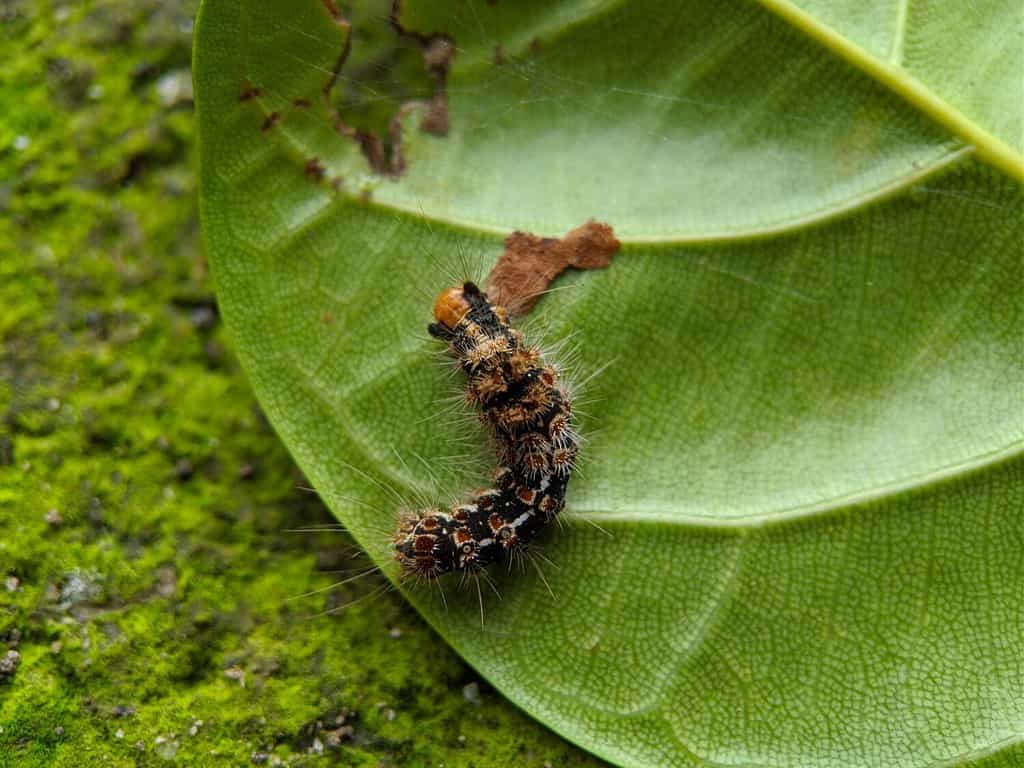
Pupation of brown-tail moth caterpillars occurs in summer and development into moths takes place by fall.
©Zikrieys Ahmad/Shutterstock.com
During the 1800s, the brown-tailed moth caterpillar unknowingly found its way to the United States. Originating from Europe, Asia, and North Africa, this invasive species has successfully established itself in select regions of New England, New York, and the Mid-Atlantic. Measuring approximately 1 inch in length, these caterpillars showcase a distinctive brown hue adorned with white markings and red spots near their tails. Caution is advised, as their barbed hairs can trigger rashes, itching, and swelling on human skin. Their diet primarily consists of trees such as oak, apple, maple, and birch. Throughout winter, they gather together in communal nests crafted from silk and hair, emerging in spring to forage for sustenance.
10. Black Swallowtail Caterpillar (Papilio polyxenes)

Feeding on milkweed plants, which contain potent cardiac glycosides, black swallowtail caterpillars store toxins in their bodies, making them poisonous to predators.
©Graphicato/Shutterstock.com
The black swallowtail caterpillar, a native butterfly larva found in North America, belongs to the Papilionidae family. With its striking black coloration accentuated by vibrant yellow stripes, it possesses a unique organ called the osmeterium. This remarkable organ serves as a defense mechanism, releasing a noxious odor to discourage potential predators. Feeding primarily on milkweed plants, which contain potent cardiac glycosides, these caterpillars have developed an extraordinary adaptation. They store these toxins within their bodies, making themselves poisonous to predators. Hatching from eggs attached to milkweed plants, the caterpillars grow and molt, eventually entering a pupal stage that lasts approximately two weeks. Finally, they emerge as fully developed adult butterflies, ready for mating and egg-laying.
11. Puss Caterpillar (Megalopyge opercularis)

The spines adorning its body hold a poison capable of delivering a painful sting.
©Chase D’animulls/Shutterstock.com
The puss caterpillar, indigenous to the Americas, is a poisonous moth caterpillar that demands our attention. With its fuzzy and segmented physique spanning about 1 to 2 inches, you never know when you might encounter this formidable creature. While its coloration ranges from brown to gray, prepare yourself for occasional variations of striking black and yellow. The spines adorning its body hold a poison capable of delivering a painful sting. Once hatched, the voracious caterpillars feast on plant leaves, diligently fueling their growth. After approximately four weeks, they enter the pupal stage, undergoing a remarkable transformation that culminates in their emergence as magnificent flannel moths.
12. Io Moth Caterpillar (Automeris io)
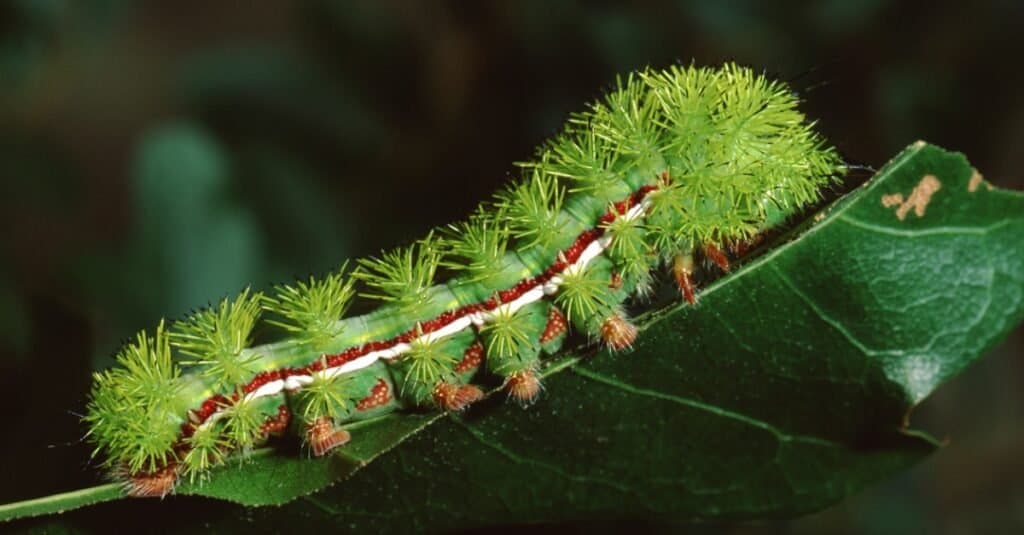
The bright colors of the caterpillar serve as a warning to potential predators.
©iStock.com/Weber
The Io moth caterpillar is a beautiful but poisonous caterpillar found in New York. It is about 1 to 2 inches long and has a bright green body with tufts of spines. These poisonous spines can cause a painful sting. However, while the caterpillar’s spines contain a toxin that may cause skin irritation, it poses no significant harm to humans. During the fall, the Io moth caterpillar undergoes pupation, transforming into a magnificent moth come spring. This large, striking creature boasts a wingspan of up to 3 inches. Adorned in vibrant shades of orange and black, it is further enhanced by the presence of captivating eyespots on its wings.
13. Saddleback Caterpillar (Sibine stimulea)

The saddleback caterpillar is a species native to North America and Mexico.
©Hagit Berkovich/Shutterstock.com
The saddleback caterpillar is an incredibly intriguing poisonous caterpillar found in New York and eastern North America. Measuring about 1 to 2 inches in length, this small creature boasts a captivating dark body with a striking green and white saddle-shaped mark on its back. What truly sets this creature apart is its poisonous spines, however, which can deliver a painful sting upon contact.
14. Gypsy Moth Caterpillar (Lymantria dispar dispar)
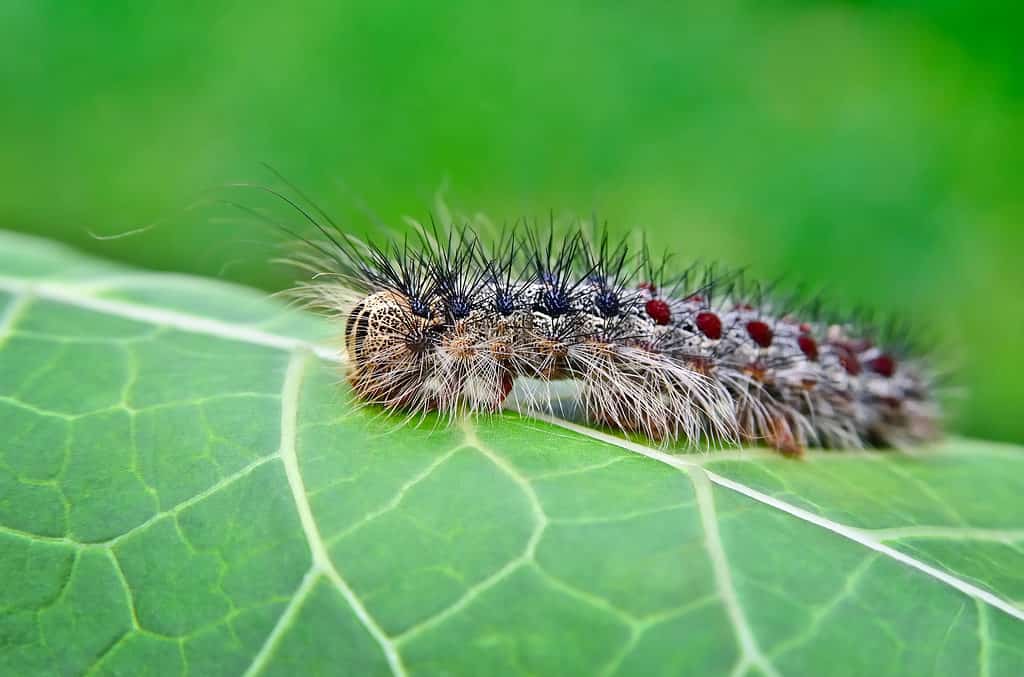
The gypsy moth caterpillar is around 2 inches long.
©Oleksandrum/Shutterstock.com
The gypsy moth caterpillar was unintentionally introduced from Europe in the 1860s. This invasive insect has successfully established its habitat across various regions of the eastern United States. Female gypsy moth caterpillars carefully deposit their eggs in clusters of 100 to 600 on tree bark, encapsulating them in a distinctive grayish-brown, fuzzy coating. Upon hatching in the spring, a remarkable transformation takes place within six to 10 weeks, as the larvae swiftly grow up to an impressive 2 inches in length. Adorned with striking white, black, and orange patterns on their brown bodies, they possess voracious appetites and can devour foliage at a startling pace, capable of defoliating extensive areas of trees. The caterpillar’s hairs are toxic and can cause itching and swelling. They can also be a nuisance when they get into the air, causing respiratory issues.
15. American Dagger Moth Caterpillar (Acronicta americana)
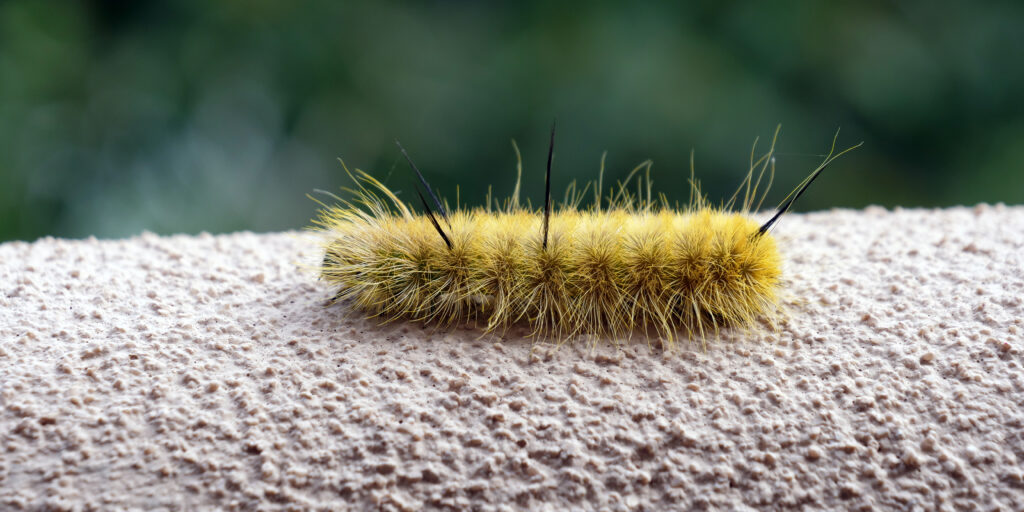
American dagger moth caterpillars have irritating hairs that can cause rashes, itching, and a stinging sensation upon contact.
©Martha Marks/Shutterstock.com
The American dagger moth caterpillar belongs to the moth family Noctuidae. Its habitat spans eastern North America, ranging from southern Ontario and Quebec to Florida and Texas. Measuring approximately 2 inches in length, this caterpillar boasts a brown body adorned with distinctive yellow and black markings. The presence of short, spiky hairs covering its body can irritate upon contact. While the caterpillar itself is not poisonous, its hairs can provoke rashes and itching. Alder, ash, elm, maple, oak, willow, and various hardwood trees serve as the nourishment for the American dagger moth caterpillar, which overwinters as eggs and hatches in spring. Pupation occurs during summer, with the emergence of adult moths taking place in the fall.
16. Leopard Moth Caterpillar (Hypercompe scribonia)
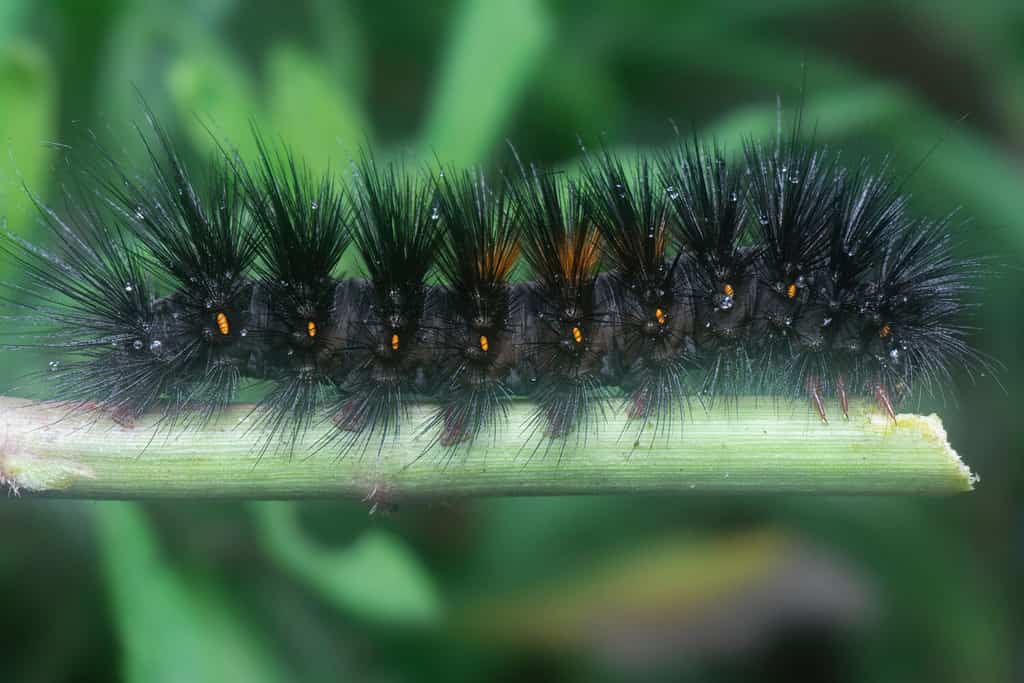
While not considered pests, these caterpillars can be bothersome in large numbers.
©Young Swee Ming/Shutterstock.com
The leopard moth caterpillar belongs to the Erebidae family and is native to North America. It can be found throughout various regions, stretching from southern Ontario and the southern and eastern parts of the United States, all the way to New England, Mexico, and Colombia. Adorned in vibrant orange and red bands, this captivating caterpillar measures just 2 inches long. Its sleek black body is complemented by silky, velvety hairs. Though mostly harmless, its hairs can irritate upon contact. The leopard moth caterpillar thrives on a diverse diet, feasting on maple, oak, and willow leaves. Winter brings dormancy, with hatching occurring eagerly in spring. Pupation takes place in summer, leading to the emergence of majestic moths in fall.
Summary of 7 Common Caterpillars in New York
| Common Name | Scientific Name | Habitat | |
|---|---|---|---|
| 1 | Eastern tent caterpillar | Malacosoma americanum | Deciduous trees |
| 2 | Woolly bear caterpillar | Pyrrharctia isabella | A variety of plants |
| 3 | Fall webworm caterpillar | Hyphantria cunea | Deciduous trees |
| 4 | Cabbage worm caterpillar | Pieris rapae | Cabbage and cruciferous vegetables |
| 5 | Karner blue butterfly caterpillar | Plebejus samuelis | Wild blue lupine leaves |
| 6 | Crecropia moth caterpillar | Hyalophora cecropia | Trees and shrubs, including poplar, maple, box elder, birch, ash, willow, and apple |
| 7 | Hickory horned devil caterpillar | Citheronia regalis | Deciduous trees, especially hickory and walnut |
Summary of 9 Poisonous Caterpillars in New York
| Common Name | Scientific Name | Habitat | |
|---|---|---|---|
| 1 | Monarch butterfly caterpillar | Danaus plexippus | Milkweed |
| 2 | Brown-tail moth caterpillar | Euproctis chrysorrhoea | Deciduous trees |
| 3 | Black swallowtail caterpillar | Papilio polyxenes | Carrots, clover, nettles, and raspberry leaves |
| 4 | Puss caterpillar | Megalopyge opercularis | Deciduous trees |
| 5 | Io moth caterpillar | Automeris io | Deciduous trees |
| 6 | Saddleback caterpillar | Sibine stimulea | Deciduous trees |
| 7 | Gypsy moth caterpillar | Lymantria dispar dispar | Willow, oak, and maple trees |
| 8 | American dagger moth caterpillar | Acronicta americana | Deciduous trees |
| 9 | Leopard moth caterpillar | Zeuzera pyrina | Deciduous trees |
The photo featured at the top of this post is © johnandersonphoto/iStock via Getty Images
Thank you for reading! Have some feedback for us? Contact the AZ Animals editorial team.







